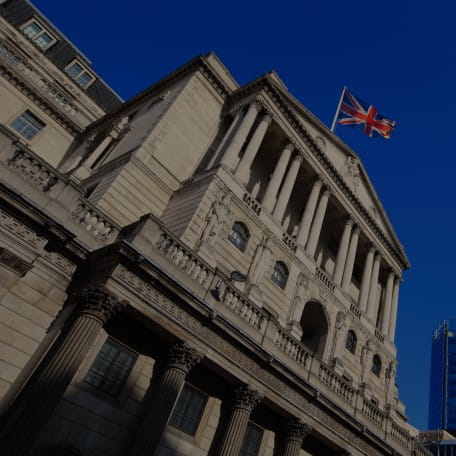Interest rates set by central banks such as the Bank of England and US Federal Reserve have been heading higher for around two years now. This has fed through to higher mortgage costs and better returns on deposit and savings accounts, but what does it mean for investors in bonds and shares?
5% government bond yields: why do they matter?
In late October, bond markets were abuzz with the news that bond yields – specifically, those on US 10 year government bonds – had edged over 5%.
You may wonder why this caused any excitement, given that developed market government bonds routinely offered yields around this level in the ‘90s and Noughties. The answer lies in the fact that yields have been exceptionally low ever since then; this was the first time that the US 10-year had hit 5% since mid-2007.
15 years of rock-bottom interest rates and low bond yields
To understand why government bond yields have recently risen, it’s helpful to remind ourselves of why they have been so depressed over the last 15 years.
2007 saw the beginnings of the Global Financial Crisis. As this intensified, central banks cut interest rates to prop up struggling economies. This low interest rate environment persisted for a decade, pulling yields on bonds down in line with central bank interest rates. Then, just as some key central banks such as the US Federal Reserve felt economies were strong enough to normalise interest rates to a higher level, Covid-19 hit. Again, policymakers opted to reduce the cost of borrowing to kickstart economic activity.
Post-covid inflation pushed rates higher
More recently, as we have emerged from the Covid-19 pandemic, supply chain bottlenecks have characterised the reopening process. This has created an inflationary problem that has forced central banks to rapidly raise interest rates from historically low levels.
While this has fed through to bond markets in the form of higher yields, this had until recently been a phenomenon that affected shorter-dated bonds more than longer ones (such as the 10-year bond). Investors had ‘priced-in’ higher interest rates in the near term, but expected central banks to cut back to very low levels once inflation was tamed. Because interest rates were forecast to revert to low levels in the medium-to-longer term, the average yield on a longer-maturity bond was still relatively low.
Will they now be ‘higher-for-longer’?
In the past couple of months there has been a notable shift in investor expectations towards rates being held ‘higher-for-longer’ as inflation proves persistent and major economies show more robustness than expected. Although interest rates may now be at or near their peak, central bankers are stressing that policy will stay at these restrictive levels for a prolonged period.
Phil Milburn of the Liontrust Global Fixed Income team thinks this shift in central banker rhetoric is a direct consequence of them being too slow to react to post-Covid inflationary pressures: “The over-riding message is higher for longer, but I suspect part of this is compensating for the farce of calling inflation transitory in the first place.”
The question facing investors is, where will yields go next? And what does higher-for-longer mean for how to position bond and equity portfolios?
Bond investors can access yields not seen for years
The 5% yield milestone itself didn’t last very long. Having hit this level on 19 October, the bonds rallied (prices going up and yields down) as investors bought back in, seemingly prompted in large part by comments from two famous investors. Firstly, US hedge fund manager Bill Ackman, who had been betting on yields rising, wrote on social media that it was too risky to remain ‘short’ of US government bonds in this way.
Later on the same day, prominent investor Bill Gross – nicknamed the ‘Bond King’ from his time running one of the world’s largest investment funds – echoed these sentiments.
Yields on 10 year US bonds are now down to 4.5% - a half a percentage point yield shift from 5.0% that would have led to an 4% investment gain through a relationship known as ‘duration’, which expresses the price sensitivity of a bond to shifts in its yield.
At these levels, Liontrust’s Global Fixed Income team see value in government bond yields. They have therefore taken a ‘long duration’ position in strategic portfolios – positioned for rising prices and falling yields. They have been increasing this bet when yields approach 5%, and trimming profits when they head towards 4.5%.
In the short term, Milburn expects yields could stay in this range: “I would characterise the US bond market as now likely to be in a holding pattern, awaiting economic data developments. If yields rally too far then one should expect some statements from Fed officials threatening higher rates. On the flip side, it is clear that the Fed will only actually raise rates further if it feels it absolutely has to, so for yields to fall much further economic data would need to deteriorate.”
Looking a little further out, he thinks the US economy is heading for a mild recession rather than a ‘soft landing’ slowdown which doesn’t tip into negative growth. “We continue to assign a very low probability to the Federal Reserve successfully engineering a soft landing. We cannot accurately predict when rate cuts will start, but we do expect them to be of a larger magnitude and faster than the market expects.”
The impact on shares
Equity investors too have been heavily affected by shifts in interest rate expectations. This is particularly true for those invested in companies considered to have high growth prospects.
For companies where the market expects strong growth for years to come, a large proportion of their current valuation (or share price) is attributed to cashflows in the future. These cashflows are valued, or discounted, according to expected interest rates. Higher growth companies have higher sensitivity to interest rate changes and can be thought of as high duration. Conversely, for stocks with lower expectations, little value is ascribed to future growth, and the bulk of value is in near-term cashflows.
Companies with strong growth expectations, therefore, have been hit hard by rising interest rate expectations and a move towards higher-for-longer.
Liontrust’s Sustainable Investment team have seen a valuation de-rating of some of their shares, a trend that fund manager Peter Michaelis thinks ignores the underlying business fundamentals of the companies:
“The high quality companies we invest in tend to have high growth prospects – meaning they are high duration [interest rate sensitivity] – and possess desirable attributes like pricing power and good profit margins which tend to result in higher share price valuations.
These companies are, in our view, best placed to cope with a period of inflation and low economic growth. But the market reaction to rising interest rates has counterintuitively led to these stocks underperforming due to their high duration and valuations, while lower-quality, lower duration companies without pricing power or strong profit margins have generated better short-term investment returns.”
The proverb “it is better to travel than arrive” is often applied to investing because asset prices are forward-looking and investment returns are driven by expectations of future events, not the arrival of the events themselves.
However, for investors in high-growth, high-quality shares, the journey to higher interest rate expectations has been painful. But perhaps there is now the prospect of a better road ahead of them. If we have finally arrived at a ‘higher-for-longer’ interest rate plateau, this group of investors could find the investment headwinds die down and maybe they can even start to enjoy the journey back if rate expectations change direction.
KEY RISKS
Past performance is not a guide to future performance. The value of an investment and the income generated from it can fall as well as rise and is not guaranteed. You may get back less than you originally invested.
The issue of units/shares in Liontrust Funds may be subject to an initial charge, which will have an impact on the realisable value of the investment, particularly in the short term. Investments should always be considered as long term.
The Funds managed by the Global Fixed Income Team:
Consider environmental, social and governance (""ESG"") characteristics of issuers when selecting investments for the Funds. May hold overseas investments that may carry a higher currency risk. They are valued by reference to their local currency which may move up or down when compared to the currency of a Fund. Hold Bonds. Bonds are affected by changes in interest rates and their value and the income they generate can rise or fall as a result; The creditworthiness of a bond issuer may also affect that bond's value. Bonds that produce a higher level of income usually also carry greater risk as such bond issuers may have difficulty in paying their debts. The value of a bond would be significantly affected if the issuer either refused to pay or was unable to pay. May encounter liquidity constraints from time to time. The spread between the price you buy and sell shares will reflect the less liquid nature of the underlying holdings. May, under certain circumstances, invest in derivatives, but it is not intended that their use will materially affect volatility. Derivatives are used to protect against currencies, credit and interest rate moves or for investment purposes. There is a risk that losses could be made on derivative positions or that the counterparties could fail to complete on transactions. The use of derivatives may create leverage or gearing resulting in potentially greater volatility or fluctuations in the net asset value of the Fund. A relatively small movement in the value of a derivative's underlying investment may have a larger impact, positive or negative, on the value of a fund than if the underlying investment was held instead. The use of derivative contracts may help us to control Fund volatility in both up and down markets by hedging against the general market. The use of derivative instruments that may result in higher cash levels. Cash may be deposited with several credit counterparties (e.g. international banks) or in short-dated bonds. A credit risk arises should one or more of these counterparties be unable to return the deposited cash. May invest in emerging markets which carries a higher risk than investment in more developed countries. This may result in higher volatility and larger drops in the value of the funds over the short term. May be exposed to Counterparty Risk: any derivative contract, including FX hedging, may be at risk if the counterparty fails. May target an absolute return. There is no guarantee that an absolute return will be generated over the time period stated in the fund objective or any other time period. The risks detailed above are reflective of the full range of Funds managed by the Global Fixed Income Team and not all of the risks listed are applicable to each individual Fund. For the risks associated with an individual Fund, please refer to its Key Investor Information Document (KIID)/PRIIP KID.
DISCLAIMER
This is a marketing communication. Before making an investment, you should read the relevant Prospectus and the Key Investor Information Document (KIID), which provide full product details including investment charges and risks. These documents can be obtained, free of charge, from www.liontrust.co.uk or direct from Liontrust. Always research your own investments. If you are not a professional investor please consult a regulated financial adviser regarding the suitability of such an investment for you and your personal circumstances.
This should not be construed as advice for investment in any product or security mentioned, an offer to buy or sell units/shares of Funds mentioned, or a solicitation to purchase securities in any company or investment product. Examples of stocks are provided for general information only to demonstrate our investment philosophy. The investment being promoted is for units in a fund, not directly in the underlying assets. It contains information and analysis that is believed to be accurate at the time of publication, but is subject to change without notice. Whilst care has been taken in compiling the content of this document, no representation or warranty, express or implied, is made by Liontrust as to its accuracy or completeness, including for external sources (which may have been used) which have not been verified. It should not be copied, forwarded, reproduced, divulged or otherwise distributed in any form whether by way of fax, email, oral or otherwise, in whole or in part without the express and prior written consent of Liontrust.










